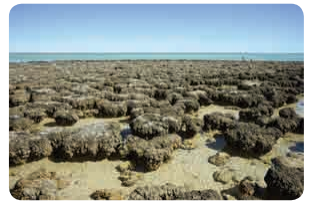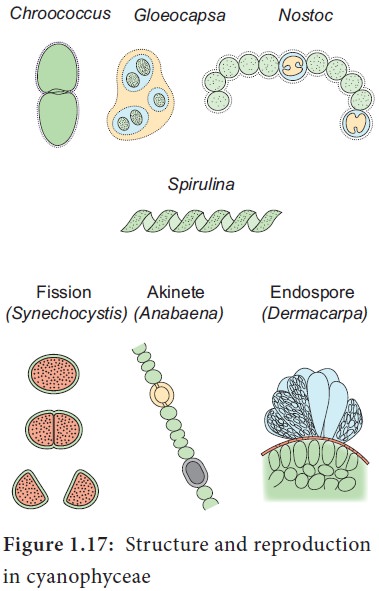Chapter: 11th Botany : Chapter 1 : Living World
Cyanobacteria (Blue Green Algae)
How old are Cyanobacteria ?
Stromatolites
reveals the truth.

Stromatolites
are deposits formed when colonies of cyanobacteria bind with calcium carbonate.
They have a geological age of 2.7 billion years. Their abundance in the fossil record
indicates that cyanobacteria helped in raising the level of free oxygen in the
atmosphere.
![]()
![]()
![]()
Cyanobacteria
are
popularly called as 'Blue green
algae' or 'Cyanophyceae'. They are photosynthetic, prokaryotic organisms.
According to evolutionary record Cyanobacteria are primitive forms and are
found in different habitats. Most of them are fresh water and few are marine (Trichodesmium and Dermacarpa) Trichodesmium
erythraeum a cyanobacterium imparts red colour to sea (Red sea). Species of
Nostoc, Anabaena lead an endophytic life in the coralloid root of Cycas, leaves of aquatic fern Azolla and thallus of hornworts like Anthoceros by establishing a symbiotic
association and fix atmospheric nitrogen. Members like Gloeocapsa, Nostoc, Scytonema
are found as phycobionts in lichen thalli.
Salient features
•
The members of this group are prokaryotes and lack
motile reproductive structures.
•
The thallus is unicellular in Chroococcus, Colonial in
Gloeocapsa and filamentous trichome in Nostoc.
•
Gliding movement is noticed in some species(Oscillatoria).
•
The protoplasm is differentiated into central
region called centroplasm and peripheral region bearing chromatophore called
chromoplasm.
•
The photosynthetic pigments include c-phyocyanin
and c-phycoerythrin along with myxoxanthin and myxoxanthophyll.
•
In some forms a large colourless cell is found in
the terminal or intercalary position called Heterocysts. They are involved in
nitrogen fixation.
•
They reproduce only through vegetative methods and
produce Akinetes (thick wall dormant cell formed from vegetative cell),
Hormogonia (a portion of filament get detached and reproduce by cell division),
fission, Endospores.
•
The presence of mucilage around the thallus is
characteristic feature of this group. Therefore, this group is also called
Myxophyceae
•
Sexual reproduction is absent.
•
Microcystis
aeruginosa, Anabaena flos-aquae cause
water blooms and release toxins and
affect the aquatic organism. Most of them fix atmospheric nitrogen and are used
as biofertilizers (Example: Nostoc, Anabaena). Spirulina is rich in protein
hence it is used as single cell protein. The thallus organisation and methods
of reproduction is given in Figure 1.17

Related Topics